“I’ve got information man! New sh*t has come to light!” –The Dude, The Big Lebowski
World Water Week runs from 23 August to 1 September[1], and so it seems appropriate to post on the absence of water. This is a post about drought, or rather about how drought can be given meaning beyond the obvious[2] (the “reveal”), as water recedes in rivers, lake, and reservoirs (and in acquifers too, but acquifers being underground don’t have reveals in the sense about to be used here, unless blowing sand or sinking land be reveals).
Of course, we have the excess of floods besides the privation of droughts. Here is a handy map of “Global change in streamflow extremes under climate change“:

So like so much else, droughts and floods are matters of distribution:
Global warming is expected to intensify the Earth’s hydrological cycle and increase flood and drought risks…. Under both forcing scenarios, there is high model agreement for increases in streamflow of the regions near and above the Arctic Circle, and consequent increases in the freshwater inflow to the Arctic Ocean, while subtropical arid areas experience a reduction in streamflow.
(Interestingly, at least according to this map, one of the large Northern nations we’d like to split into smaller units seems to be doing very out of this “intensified hydrological cycle.” No, silly! Not Canada!)
Perhaps I shall write about floods another time. However, I’m more interested by what is revealed when fresh water vanishes, rather than the junk and chaos left behind when ocean water recedes[3]. In drought, that which once was hidden appears; the return of the repressed, one might say. In this post I’ll present a collection of images that show the objects and entities revealed by drought, and then conclude with some far-fetched speculation. (Here are some general posts on climate change and drought: Bloomberg, Smithsonian, Sydney Morning Herald, NBC, Guardian). To the images!
Bodies (Lake Mead, Nevada)
From the Daily Mail, this grim memento mori:
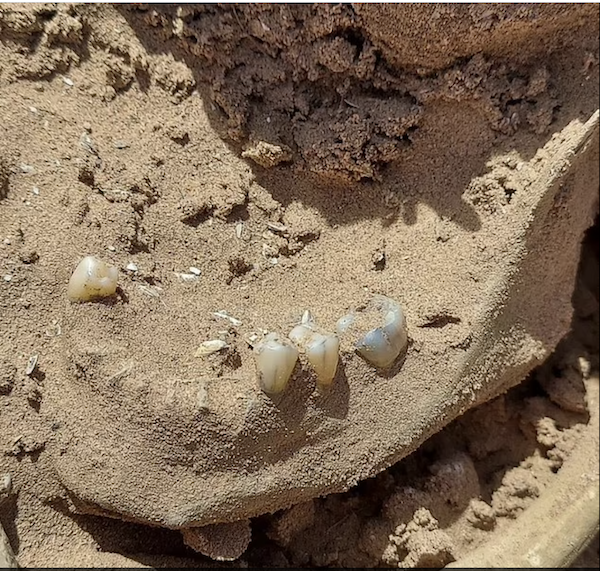
We have a name:
Thomas Erndt drowned in Lake Mead on August 2, 2002, according to the Clark County Coroner.
His remains were found at Callville Bay, located in the northwestern side of Lake Mead – the largest reservoir in the US – on May 7 and is one of the five sets of bodies found there since May 1.
Many bodies have been popping up in the lake – which is rumored to be a ‘mob-hit dumping ground’ as some of the bodies were found with gunshot wounds similar to that of mob-style – as the water level has fallen past historic lows.
I did do a search to see if either Breaking Bad or Better Call Saul had a body-dumping episode, but apparently not. We do, however, have a very Vegas lawyer:

Dinosaur Footprints (Dinosaur Valley State Park, Texas)
From Glen Mills of Texas Parks and Wildlife, dinosaur tracks. Big ones:
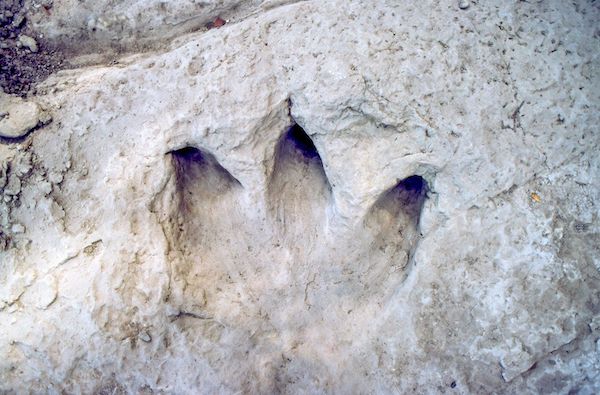
The Wall Street Journal writes:
When the waters of a Texas river receded this month, they unveiled a secret from 113 million years ago: a trail of dinosaur footprints.
The tracks in the Paluxy River weren’t just from any dinosaur, but a giant among giants. An Acrocanthosaurus—a 15-foot-tall, seven-ton beast—left behind prints that would dwarf a human foot, the Texas Parks and Wildlife Department said Wednesday.
Officials discovered the tracks earlier this month at the Dinosaur Valley State Park in Somervell County, which is about 40 miles southwest of Fort Worth. The park is known for its cache of footprints that dinosaurs had made at the edge of an ancient ocean.
No one knew about this set of Acrocanthosaurus footprints until a severe drought desiccated the Paluxy River, which runs through the park, said Stephanie Salinas Garcia, a spokeswoman for the state parks and wildlife department.
“The river dried up completely in most locations, allowing for more tracks to be uncovered here in the park,” she said. They had been shrouded before in mud and sediment, which helped preserve them from natural weathering and erosion, she added.
So the footprints are excellent and sharp, making some paleontologist happy.
Ghost Gardens (Lydiard Park, England)
From the the Friends of Lydiard Park, gardening
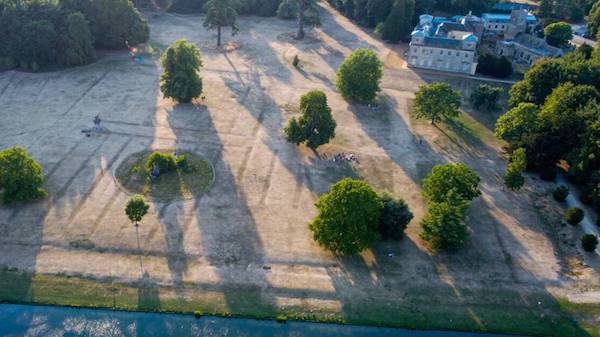
The Miami Herald writes:
The expansive lawns of grand estates across England have shriveled under the summer’s heatwave and drought, revealing remnants of long-lost gardens, according to caretakers.
Time turned backward on the sunbaked lawn of Chatsworth House — a royal estate about 150 miles northwest of London. The parched ground revealed a “lost” 17th century garden usually “hidden from view”…
Drone footage showed the lawn with wide swaths of scorched Earth forming a cross around a central fountain. At one end, dramatic curves look like waves. In other portions, the ground shows intricate, swirling fleur-de-lis-shaped patterns.
These were a European-style garden with “ornamental arrangement of flower beds and paths” in 1699, the estate explained. But the garden went out of fashion. Around 1730, the grass of a new design covered the landscape features, hiding them from visitors for the next nearly 300 years, the estate said.
A 300-year-old lawn gets its comeuppance [snarl]. So there’s a bright side.
German Battleships (The Danube, Prahovo, Serbia)
From Twitter account @khalediskef:
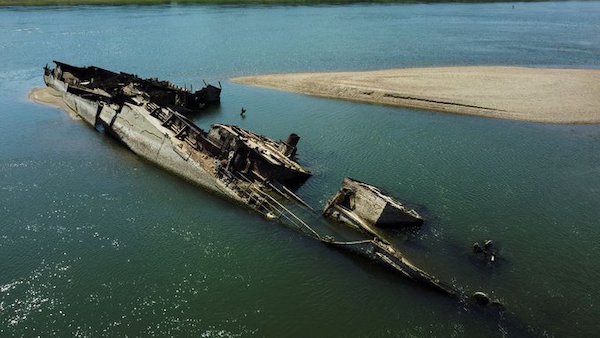
At present, Europe is recording high temperatures and is also facing the risk of drought in the entire region. The drought has revealed several findings, however. In a recent finding, more than 20 German warships that were sunk during World War II have re-emerged in the Danube River in Serbia. The warships still contain ammunition and explosives and are stretched along the river near Prahovo, Serbia’s river port town.
According to media reports, the Danube’s water level had hit its lowest level in almost a century. Ships that were discovered belonged to Nazi Germany’s Black Sea Fleet. They retreated from advancing Soviet forces in 1944. These battle warships affect river traffic whose main arteries run via Germany, Italy and France when the water level drops.
Speaking of the return of the repressed….
Hunger Stones (The Elbe, Germany and Czechia)
Wikipedia explains the concept:
A hunger stone (German: Hungerstein) is a type of hydrological landmark common in Central Europe. Hunger stones serve as famine memorials and warnings and were erected in Germany and in ethnic German settlements throughout Europe in the 15th through 19th centuries.
These stones were embedded into a river during droughts to mark the water level as a warning to future generations that they will have to endure famine-related hardships if the water sinks to this level again.
(I like the concept of hydrological landmarks, and I wonder if any readers have spotted any[4].
Via Dr. Bernd Gross:
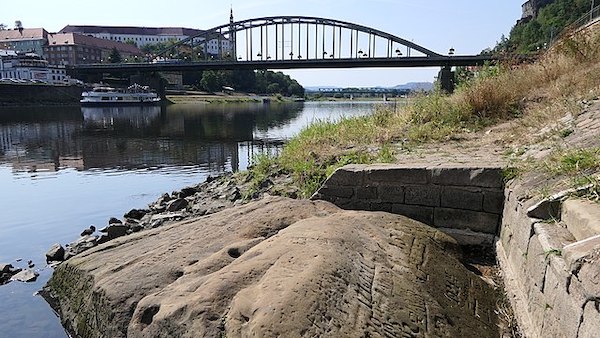
The concept of hunger stones was brought to wider attention in the 19th century by newspapers and travelogues, the mass media of the time. In 1904, the Děčín stone became the target of daily tourist excursions, and had to be protected from destruction by a wall built around it. Thousands of postcards showing the stone were sent from the town all over the world. In the 1930s, an inscription in Czech was added, reading: “Girl, don’t cry and moan when it’s dry, water the fields instead.”
As the top map shows [see the link], the hunger stones are a phenomenon with a very limited geographic scope. More than two dozen hunger stones can be found in the Elbe, with a particular concentration on the stretch on either side of the German-Czech border.
Stone Buddhas (The Yangtze, Chongqing, China)
Via Twitter account @stevievzh:
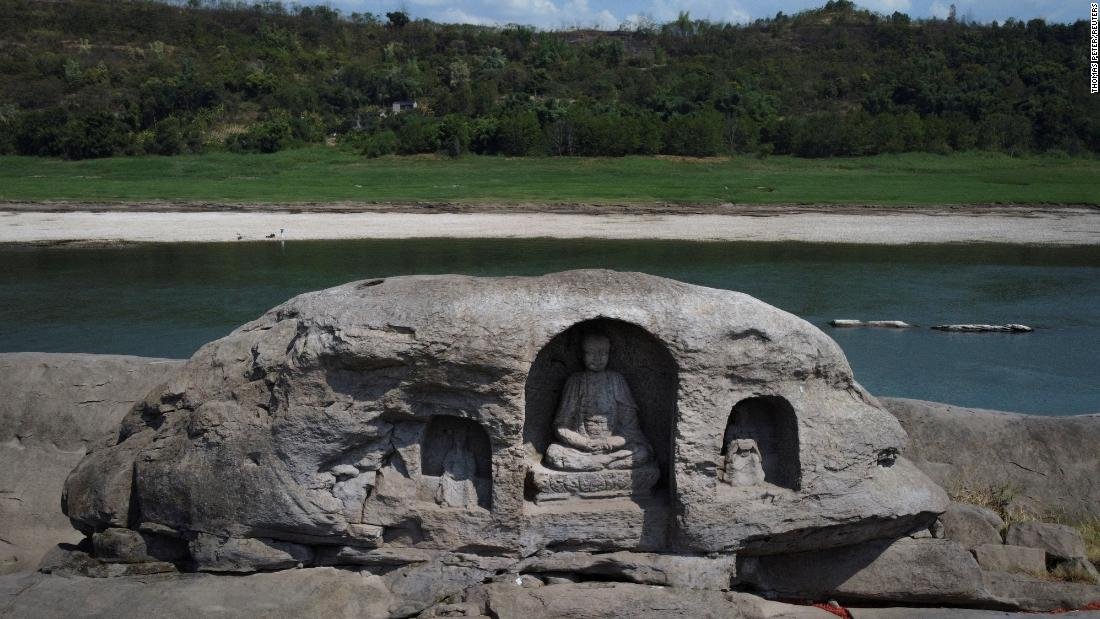
NBC writes:
The Yangtze, Asia’s largest river and a crucial part of China’s economy, has seen its water levels fall rapidly amid a drought and record-breaking heat wave.
This has revealed three ancient Buddhist statues atop a normally submerged island in the Chongqing area in the country’s southwest.
The relics feature three monk-like figures sitting and watching over the river that are believed to be about 600 years old and built during the Ming dynasty, which ruled China from 1368 to 1644.
Spanish Stonehenge (Valdecanas reservoir, Guadalperal, Spain)
Via Al Mayadeen:
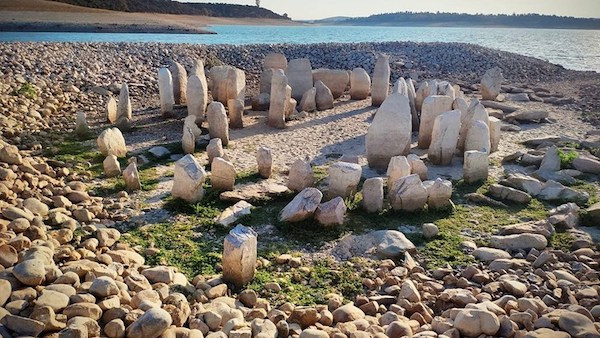
Severe droughts in Europe have caused alarm among its residents, but an unexpected side effect of the country’s worst drought in decades has brought delight to archaeologists as the emergence of a prehistoric stone circle is discovered in a dam whose waterline has receded.
Known as the Dolmen of Guadalperal but dubbed the Spanish Stonehenge, the circle of dozens of megalithic stones is believed to date back to between 4,000 to 7,000 years ago.
The Dolmen structures were discovered by German archaeologist Hugo Obermaier in 1926, but the area was later flooded in 1963 in a rural development project under Francisco Franco’s dictatorship. It currently sits in one corner of the Valdecanas reservoir, located in the central province of Caceres, where authorities recorded water levels dropping to 28% capacity.
Archaeologist Enrique Cedillo from Madrid’s Complutense University, one of the experts racing to study the circle in fear of it getting submerged again, commented, “It’s a surprise, it’s a rare opportunity to be able to access it.”
Optimistic experts!
The City of Zakhiku (Mosul Dam reservoir, Kurdistan, Iraq)
From the Universities of Freiburg and Tübingen:
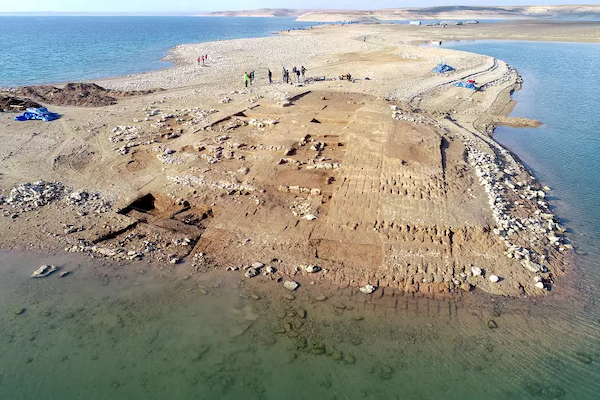
Earlier this year, the remains of a 3,400-year-old city emerged from a reservoir in Iraq after months of extreme drought.
German and Kurdish archaeologists uncovered the ancient settlement from the Mittani Empire when water levels fell rapidly. It was once located on the banks of the Tigris River and is believed to have been the city of Zakhiku, an important centre for the Mittani Empire which lasted from around 1550 to 1350 BC.
Researchers were shocked to discover well-preserved walls made from sun-dried mud bricks. Some had been underwater for 40 years since the Mosul Dam was built and the reservoir created.
They attribute this surprising preservation to an earthquake that destroyed the city in 1350 BC when the upper parts of the walls collapsed, burying the buildings completely.
(Other submerged cities along the Tigris and the Euphrates here.)
Conclusion
As a former humanities major and, well, dabbler in proscribed substances, the image of the drowned city, revealed, resonates the most with me. The drowned city most familiar to readers may be H.P. Lovecraft’s R’lyeh:
The nightmare corpse-city of R’lyeh…was built in measureless eons behind history by the vast, loathsome shapes that seeped down from the dark stars. There lay great Cthulhu and his hordes, hidden in green slimy vaults.
(Whatever it was that “seeped” down from the “dark stars” reminds me of petroleum — “slimy” and filling the “vaults” of carbon-profiteering death-eaters.) Poe, also, has his poem, The City in the Sea[5].
By whatever workings of the collective workings of our “deep well of unconscious cerebration“, the drowned cities of both Poe and Lovecraft align neatly with the drowned cities of Romantic poets — and opium addicts — Thomas DeQuincy and Samuel Taylor Coleridge:
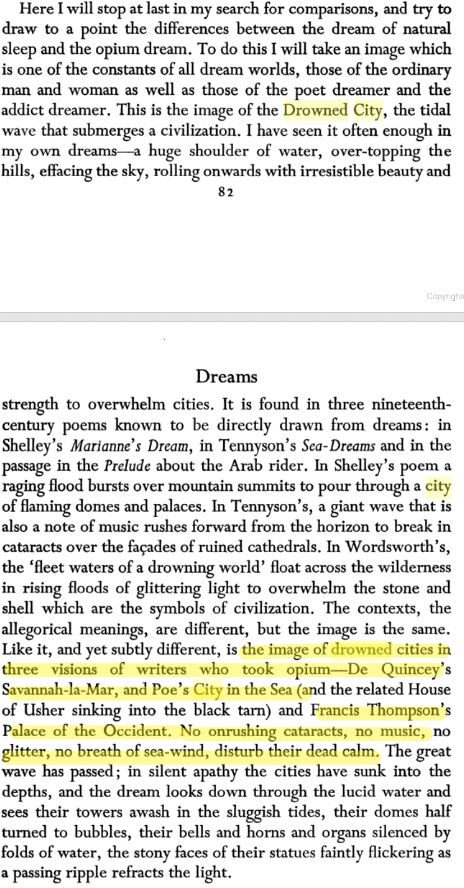
The “dead calm” and “apathy” of the Romantic drowned city is, of course, the Romantic poets’ objective correlative to the realities (and losses) of addiction. We might, then — I think I foreshadowed some far-fetching? — compare the Romantic opium addict’s “silent apathy” to our own subservience to another substance addictive, albeit socially: oil.
But what happen when the drowned city — or skull, or dinosaur track, or garden, or Nazi battleship, or hunger stone, or Buddha — is revealed?
Perhaps what happens at any “reveal,” a TV term I have taken my own sweet time getting to. From the obsessive and wonderful TV tropes, the reveal of the reveal:
The pivot in many plotlines is the Reveal. A character is revealed as another character’s father, a god, or secret suitor or arch nemesis in disguise. More broadly, the audience is given new information which had been withheld to create suspense. The Reveal changes the nature of the plot, often pushing it from suspense towards action. A good reveal will also create a new set of questions and further suspense…. Aristotle referred to it as anagnorisis (generally translated as “discovery” or “recognition”) in his Poetics, making this one Older Than Feudalism.
Generally, the “moment of discovery” for Greek dramatists was designed to evoke pity and terror in the audience. In the reveal, that which has long been repressed is made visible. But let us ask ourselves: Under neoliberalism, what is repressed? I would say everything but the lust for gain (see Rule #1).
When the waters of neoliberalism recede, what would the reveal of the reveal of the reveal be?
Possibly, skulls and Nazi battlewagons. But also mementos in the form of dinosaur footprints of how long life has persisted on this earth, in how many forms. Mementos of the human quest for order in beauty (granted, in the form of lawns). Mementos of the human quest to help the next generation survive in the form of hunger stones. Reminders of human self-organizing capacity in the form of stone circles and cities. And, of course, the Buddha.
So I don’t think the reveal of drought is all bad (reveal of the reveal of the reveal of the reveal, as it were). And if we equate — with Lovecraft? — the receding fluid that’s truly been drowning us — holding us breathless in stasis — not with water, but with oil, the net reveal may ultimately be all to the good (if we’re not collectively too stupid and have some luck). So perhaps there will be no tentacles at all when the drowned city of R’lyeh emerges. Wouldn’t that be nice?
NOTESa conference in Stockholm. From what I can tell on the Twitter, masking is minimal [pounds head on desk]. I can only hope the ventilation is good.
[2] The report by the UN on which the story is based is worth reading; disaster deaths have actually gone down due to “improved early warnings and disaster management.” Of course, life expectancy in the United States had been going up for a long time, too, so perhaps this is a temporary arrangement.
[3] I confess to a liking for Japanese tsunami videos.
[4] Other “annotations”:
I’ve been mildly obsessing about our ancestors annotating the planet — hunger stones, tsunami stones, flood markers, Nilometers, etc.
Their basic message: if you’re below this line, you’re screwed.
A few links follow. Feel free to tell me what I’ve left out.
— tnielsenhayden (@tnielsenhayden) August 21, 2022
[5] From whose lines, “While from a proud tower in the town / Death looks gigantically down” the popular historian Barbara Tuchman took the title of one of her books.


I went to Las Vegas once. Las Vegas is America’s very own Temple City of the Fun Gods.
If we can’t have everything, I would sacrifice all the irrigated agriculture in California to save Las Vegas even if I never go there again. Just to know it is still there, still America’s Temple City of the Fun Gods.
To follow Lambert’s reference to Lovecraft, I’ll observe that Las Vegas, once it returns to the desert sands, (probably a figure of speech, parched badlands being more accurate a description of the landforms of that area,) will become like Lovecraft’s fabled cursed city buried by the sands of Arabia; Irem, the City of Pillars.
Both places being the revenants of once flourishing Cities of Sin, similar fates await. Nameless ‘things’ lurking in shadowy hidden places to spring out and consume the unwary traveler. [Wait now. I just described the present day Las Vegas. Haven’t I?]
Anyway, keep your Mnar Stones handy far traveler.
Maybe I’ll go back there one more time before its gone.
High summer was a bad time to go. Temperature ( without any heat-index games) was 107 degrees. I saw a mockingbird perched on a branch with its wings drooping and its mouth open. It looked hot and unhappy.
I saw some of the local grackles jumping around on some tables. They looked much longer-legged in proportion to their bodies than the grackles we have here. They really did look like little dinosaurs refitted to be birds. Birdiesaurs.
The Fun Gods are definitely not cheap…
Cheaper than the irrigated fun fruits, fun vegetables, fun almonds and fun wine of California, Arizona, etc.
Somehow, California, Arizona fits. Sort of like that wonderful, extremely productive metropolis in Post WW-2 Japan, USA. I actually have a geegaw marked: Made in USA. It is marked elsewhere: Nippon.
It appears they are at Norra Latin, a 19th century school in the middle of Stockholm. Lots of stone and high ceilings, the kind of hallways that looks like they will echo a lot from footsteps.
I took a stab at searching for anything on the web about their ventilation, and to my surprise found information. Apparently the owners has a sustainability project and as part of that has overhauled the ventilation, installing CO2 and temperatur readers that in turn controls the flow. So odds are, the ventilation is rather good.
But yeah, masking is not common in Stockholm. When I go there I see few others with masks (never got any negative comments about mine, quite the opposite), maybe 2% in the subway.a conference in Stockholm.
The safer and lowest CO2 option – which is offered – is to attend online.
Wasn’t Sweden always a deeply anti-masking place all through the pandemic?
Not really anti masking as such, the government mostly recommended and asked the citizens to mask up and stay away from each other (the latter is generally not needed as Swedes tend to give strangers plenty of space).
Most considered masking a sacrifice of convenience by the person wearing them, and thus were not seen as something bad, mostly something that they themselves wouldn’t do, but if you did then bully for you.
I personally considered masking up to cause a slight reduction in how contagious the wearer were, and considering how few N95 masks were available and correctly worn, mostly theater but for the most part a way for people to feel in control over something truly outside of it. A low level stress benefit in general.
M Fjallstrom, thank you for this information. Not that I worry about them a lot…
Very thoughtful read for a Sunday afternoon in Puget Sound. It has not rained here since early July, but that can happen when the summer high pressure area sets in. Moving here from Northern California has had the intended effect: the color green is back, beautiful water sights around the sound, and lovely mountains all around. I am well aware that the “reveal” for neoliberalism is coming. Those, like you, who have been looking for it can already see its stark outline.
Much of the story will be about water. Much of the story IS water.
There’s a Big One overdue, in the sequence of past Big Ones that have affected the Peugeot Sound area, with its lovely views and outrageously priced housing and other “amenities.” Here’s an interpretive simulation for those who want to see what different levels of crustal energy release would do to the Emerald City and surroundings:
https://nctr.pmel.noaa.gov/pugetsound/pre2/
I spent seven years in Seattle, slaving in a Big Law Firm that has since been swallowed by two Bigger Big Law Firms. Got to feel a couple of earthquakes and watch the surface of Lake Union dance. I’ve become a “native Floridian” now (been here 25 years) and do not miss the Seasonal Affective Disorder or the frenetic competitive insanity of the Northwest at all. I feel a little empathy for the homeless created and maintained by that consumptive drive and its approach to an asymptotic peak. Not so much for the Bill Gateses and other squillionaires with their “compounds” that violate all the zoning and community planning dictates that affect the lesser orders. May they crash and burn and be eaten by Chthulu and its minions. Or maybe like the joke about the three guys hoping to escape from a desert island by swimming to the mainland through shark-infested waters to summon help — the lawyer went for it, the sharks actually helped him make it to shore, the doctor and the priest noted it was just an extension of professional courtesy — so the feudal lords might just get a leg up from Chthulu on that same basis…
I enjoyed this post very much. It got my imagination firing and stimulated cresting of waves of thoughts upon the past, the future, … what was, and what will be — what is to come. We live in most interesting times.
I strongly believe this post supplemented with my further researches might prove a true fountain of inspirations for me for creating cycles of short stories, myths, fairy tales, parables and aphorisms. I find solace in the belief that story tellers will always be welcomed and honored at campfires and on village meeting grounds. I grow too old to offer much else which might garner a warm place by the fire. Time to build stories and collect remembrances that might prove fertile sources for stories. Your post will have its place of honor in my random collection of inspirations. If my time is too soon, I will pass my thoughts and ideas to my children in hopes for their earning modest comfort for their later years.
If I can find some Wisdom, I would wrap it in an entertaining and compelling story.
> I strongly believe this post supplemented with my further researches might prove a true fountain of inspirations for me for creating cycles of short stories, myths, fairy tales, parables and aphorisms.
Please keep us posted!
This post was hard to write, except for aggregating the photos, and I’m not sure I ever fought my way to the central idea, which was (or is now):
1) What is revealed by the receding waters is the return of the repressed (e.g., bodies in Vegas, but also Buddhas)
2) What is repressed under capitalism (neoliberalism) is that which is good. The endless quest for capital accumulation destroys everything else, especially the “everything else” that makes it worthwhile to be human. So the return of the repressed may bring forth a lot of good. It won’t stop the Jackpot, but the Jackpot may take a different form from that envisioned by Gibson
The metaphor of the drowned city makes this clear. The static drowned city is a metaphor for addiction. Our addiction is not to water, but to oil (as Lovecraft makes clear). Hence the receding of oil would mean the end of our civlization’s addiction (good) and the city revealed would have “no (Cthulhu-ian) tentacles” (good).
I used to write poetry when I was young, foolish, and had nothing to say. I think that’s what this post was trying to be, now that I think of it.
Lots of cars too I would imagine.
Now imagine what is supposed to become of hundreds of millions of gasoline powered vehicles….
https://www.youtube.com/watch?v=evMBPlBlUrs/
Clip from a movie about the future. Everybody was driving electric vehicles by this time in the movie.
A long queue of Teslas in California waiting at a charging station
https://www.youtube.com/watch?v=AU_K2NhD_1I&t=2s
I don’t know about Nazi “battlewagons”. The only battleship and cruisers were Soviet and were important in defending Sevastopol from German/Romanian attacks, but eventually had to abandon the Crimea and move to Georgia.
Due to the montreux convention Germany was unable to provide significant naval support for the war in Ukraine, support mainly coming from the small Romanian Navy. Germany was able to move some u-boats and auxiliaries via the Danube.
We are probably talking about coastal and riverine craft, not actual “battleships”–an annoying habit common among people who are not sticklers for naval terminology. We are talking about the Danube, where, historically, armed riverboats have been a big deal, after all.
Yes, I think only the Romanians had a few vessels above 1,000 tonnes – a few destroyers. The German forces were almost entirely small fast torpedo boats (S-boats) and R boats (small multipurpose minesweepers). I think they also put heavy guns on barges. I don’t think the Germans even had river boats as such – everything they had was designed for the Atlantic or Baltic. But the S-boats were formidable as night attack craft, perfectly capable of sinking much larger vessels if they could get close.
As for the other photos, I think the Chinese buddha statue owes more to a local tourism organisation trying to get publicity than anything else. The photos I’ve seen show clear water erosion on the lower layers of rock, but the carving and surrounding rock are weathered with no sign of water smoothing. Chinese rivers carry a heavy sediment load that quickly smooths out any rock it its path. So I doubt very much if that statue has spent much time below the river level.
Don’t overlook the possibility of Austro-Hungarian river monitors left over from WW1.
That’s the warship, not the lizard.
Soviets were also big on heavily armed riverboats and, after annexing Bessarabia and North Bukovina, they put together a Dunube flotilla by transferring ships from other rivers emptying into the Black Sea. Not sure how big these boats were, though.
> The photos I’ve seen show clear water erosion on the lower layers of rock, but the carving and surrounding rock are weathered with no sign of water smoothing. Chinese rivers carry a heavy sediment load that quickly smooths out any rock it its path. So I doubt very much if that statue has spent much time below the river level.
Good points!
I’ll add to Poe and Lovecraft, J G Ballard’s novel “The Drowned World.”
Ballard, being the product of “growing up” as a teen in a Japanese internment camp for Europeans at Shanghai, had an early and predictive catastrophist imagination.
Catastrophe is the best word I can think of to describe the collapse of the Neo-liberal World Order (NWO.)
Continuing, I can suggest that what we are seeing the beginnings of is not the collapse of an Empire, but the collapse of a Culture. Something similar to the collapse of the Bronze age civilizations of the Eastern Mediterranean Basin circa 1200 BC.
I usually say at this point in my comments, “Stay safe.” However, safe from what, and is there any ‘safe’ place left? So, think local as you observe the world around you crumble.
[Maybe I should change the “handle” for some of my comments, the more dour ones, to ‘unambrit.’ *Dings a bell* and chants: “Unclean! Unclean!”]
The opening line of Ballard’s novel could serve as a 21st century epitaph.
“Soon it would be too hot.”
His evocation of a literally drowned London is almost like Conrad describing the Congo River at the turn of that century.
I think Spengler would argue that the beginning is long past us. IMPO, it’s more likely that we are at a phase transition level, where qualitative change falls on us like a ton of bricks.
Good point. I have heard it argued that the defining point of when “The Beginning” is past is when a situation passes the point after which the initial changes can no longer be rolled back. The Past is well and truly gone at that point. It’s a systemic point.
As I was reading this, I thought of what is known around here as Indian Head Rock, an 8-ton sandstone boulder which formerly sat at a low point in the Ohio River, upriver from Cincinnati at Portsmouth, OH. Since the river’s 19th century impoundment for boat travel, the rock had sat submerged under water. Until.
In proper American fashion, a few local Ohio scuba divers who first heard about it in 6th grade history located and in 2007!illegally removed the rock to their hometown Portsmouth, to serve as a tourist attraction to spur their dying community. This led to a number of lawsuits by the state of KY, I think some featuring now-KY governor Andy Beshear as Attorney General. (KY claimed the rock came from their side of the Ohio River.)
KY won most of the suits and now this Ohio River hunger stone , if that’s what it is, sits in a warehouse in Greenup County, KY.
https://en.m.wikipedia.org/wiki/Indian_Head_Rock
Very interesting post this. Among those discoveries I would add to that the Ruins of a Roman camp that was uncovered in Spain. Real good stuff and bonus time for archaeologists-
https://www.thelocal.es/20220812/in-pictures-drought-in-spain-intensifies-as-roman-fort-uncovered/
But maybe there might be opportunistic with water levels so low. Here in Oz when there is a drought and the dams of the farmers dry up, they take the opportunity to make those dams deeper for when the rains eventually return. So maybe now is a time to do maintenance work where it can be done. So if a canal is dried out, now is the time to clean it out thoroughly and give it a good inspection. If water intakes are uncovered, check them out and see if they need cleaning or any modifications.
Nice thought. By which governments? With what resources? That’s another reservoir that has been sucked dry.
Thank you for this piece, Lambert. With drought in my location and my family elsewhere flooded out, I have been much concerned with these lines of thinking. Something it brought to mind that readers here may enjoy:
“Oil” by Gary Snyder
soft rainsqualls on the swells
south of the Bonins, late at night. Light
from the empty mess-hall
throws back bulky shadows
of winch and fairlead
over the slanting fantail where I stand.
but for men on watch in the engine room,
the man at the wheel, the lookout in the bow,
the crew sleeps. in cots on deck
or narrow iron bunks down drumming
passageways below.
the ship burns with a furnace heart
steam veins and copper nerves
quivers and slightly twists and always goes—
easy roll of the hull and deep
vibration of the turbine underfoot.
bearing what all these
crazed, hooked nations need:
steel plates and
long injections of pure oil.
I haven’t read Gary Snyder in years. Thanks!